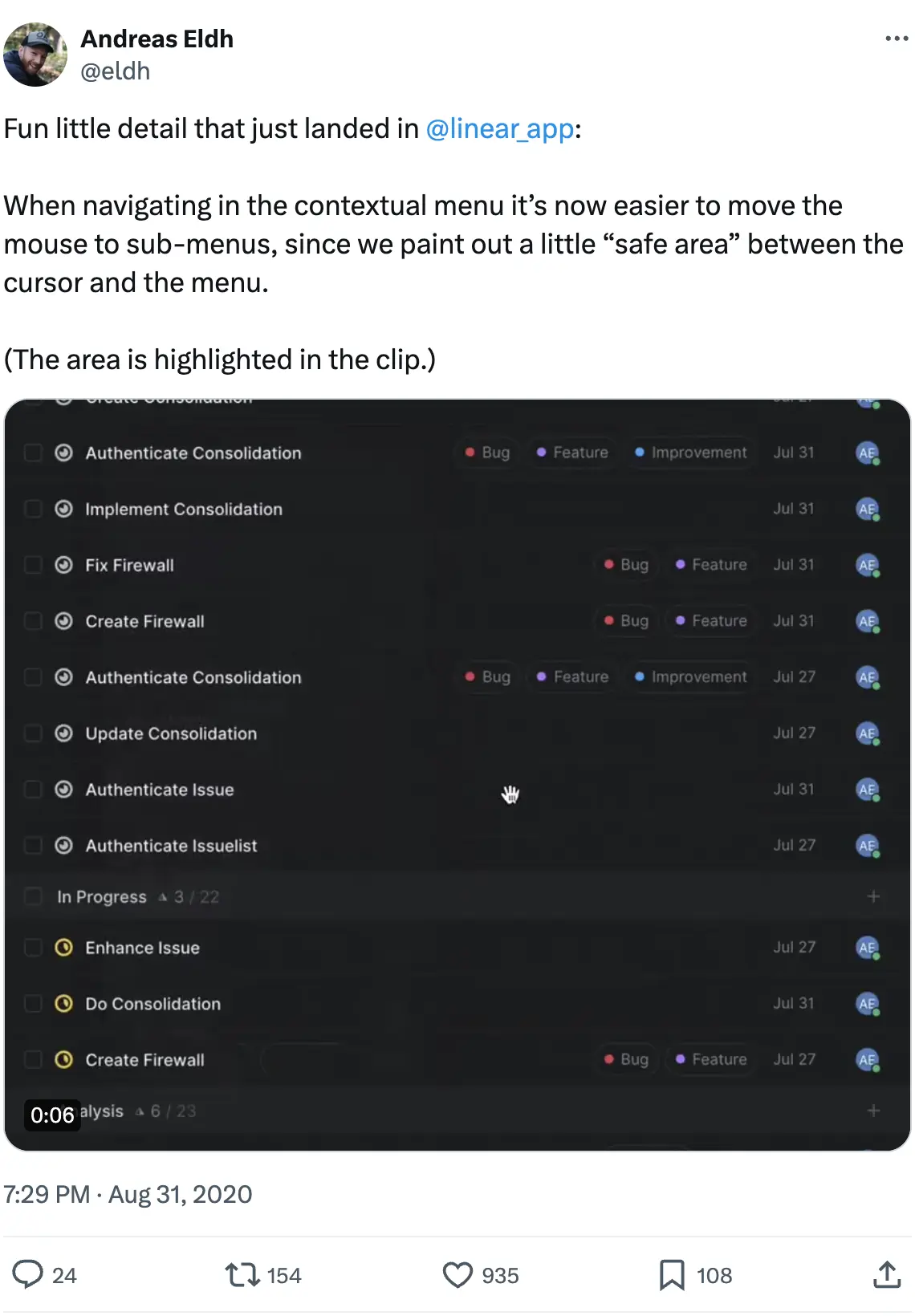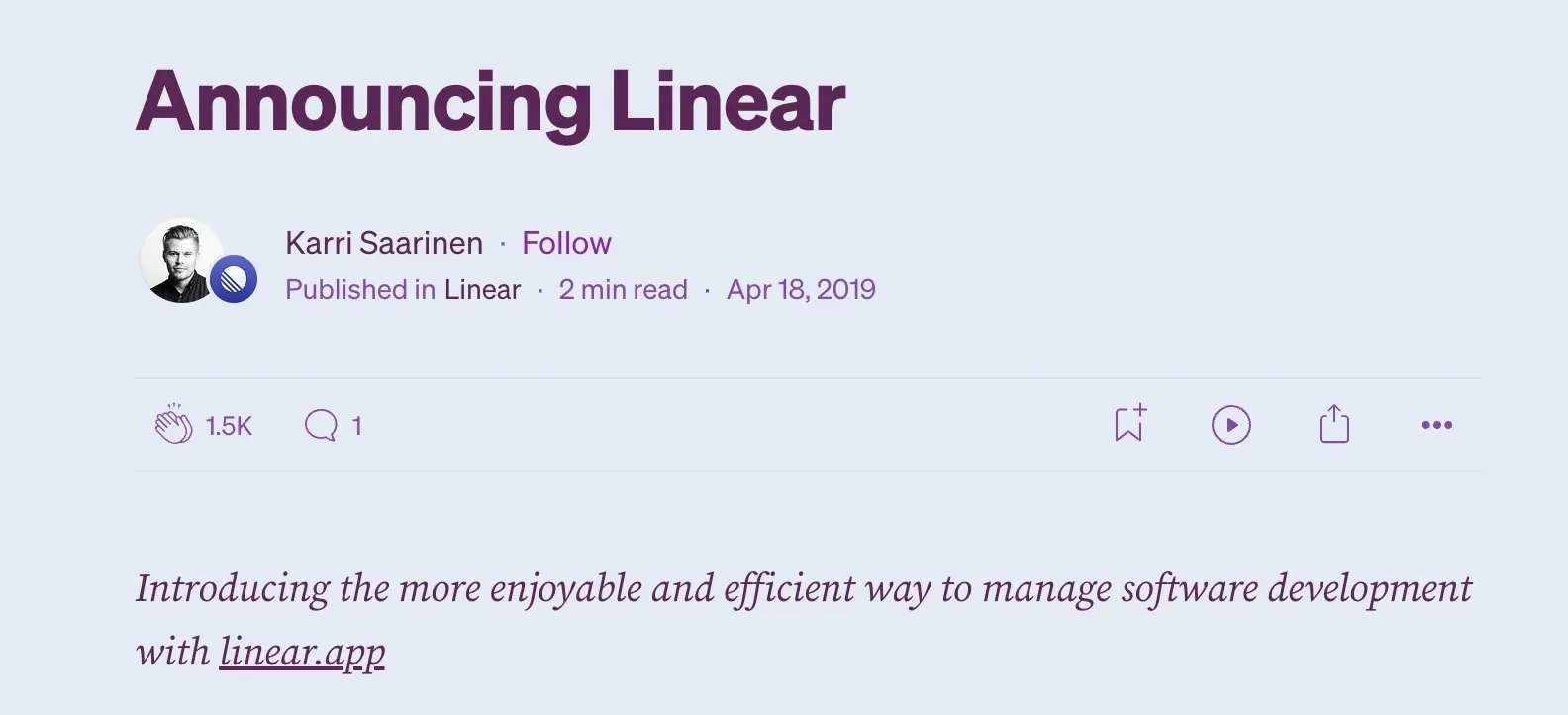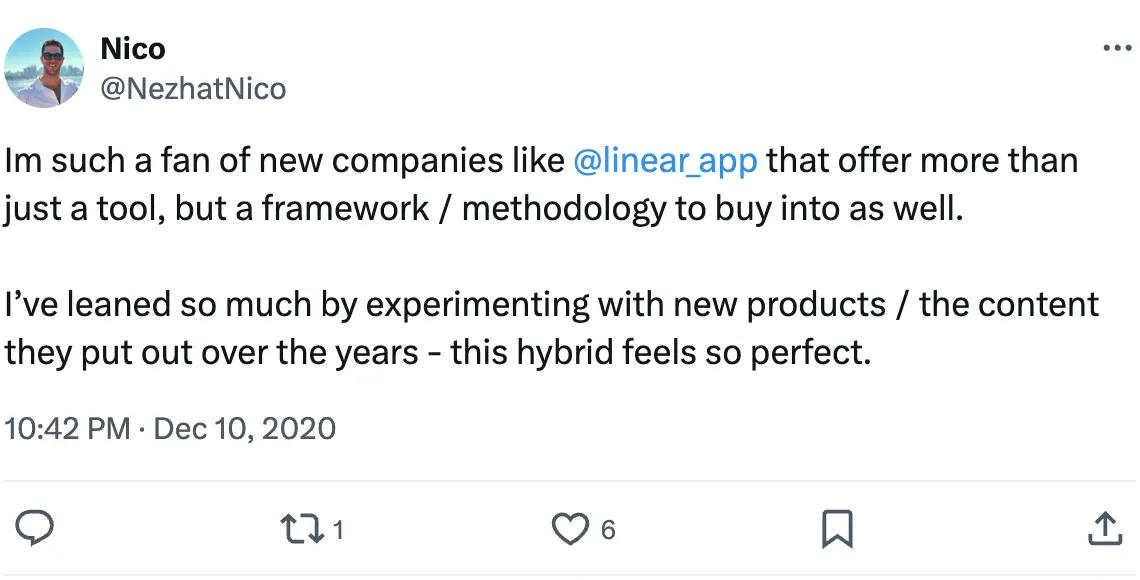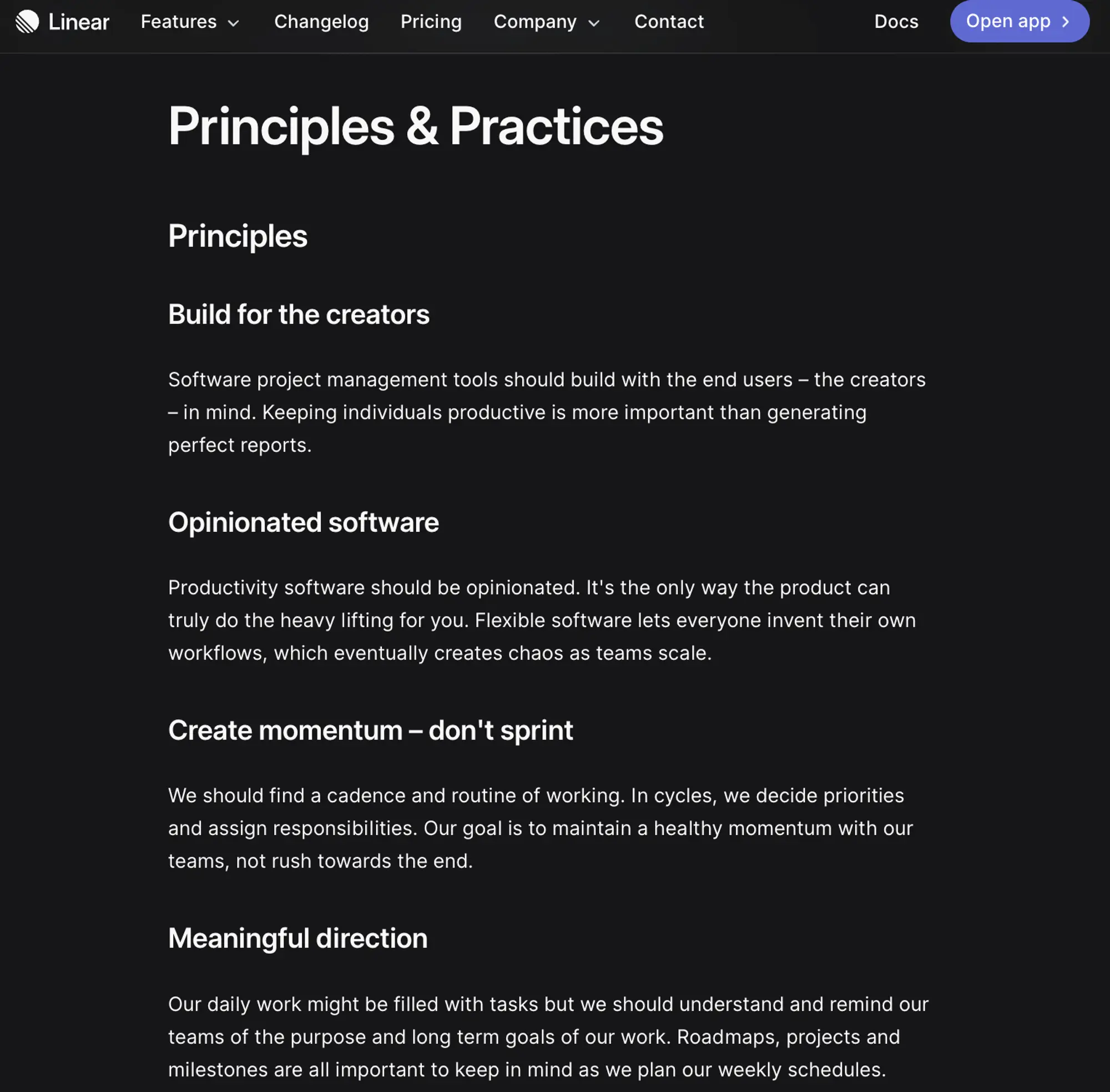We recently published our CommandBar manifesto. It’s an article that won’t rank on Google and isn’t technically “product marketing”. Publishing it might feel self-indulgent. But we believe it’ll become one of our most important marketing assets.
The simplest questions are often hardest to answer: Why does God allow suffering? What’s the meaning of life? And why is Linear so damn popular?
Seriously. Success usually leaves clues—you can trace Hubspot’s hypergrowth to mastering blog traffic, Dropbox’s to a referral scheme and Mailchimp’s to an (at the time) ludicrous ‘forever free’ plan.
Linear was just there one day and everyone loved it. From a product perspective, there’s the obvious stuff: As a collaboration tool, Linear has network effects. Like Figma, Linear is bottom-up: One person can start using it, invite their team, which invites other teams, making Linear spread inside companies.
But those properties apply to many SaaS tools, most of which have nowhere near Linear’s mouthwatering traction: More cash in the bank than they ever raised in venture capital, a reported valuation of $400m and a lifetime ad spend of $35k.
Yes, that’s right. Linear has barely spent anything on marketing. Neither do they follow any other “best practices”:
- They don’t battle for search rankings with articles like “15 tips for project management”.
- Their socials announce features, but don’t entertain or educate.
- There’s no $500 referral bonus.
But Linear has an aura. Even social posts about fun little details (their words, not mine) can get massive engagement:

C’mon. If I posted this about some delicious but small detail in CommandBar, almost guaranteed crickets (except from our loyalists — <3 you guys) That’s 1000+ interactions for something that would barely make a changelog bullet at many companies!
Its founder/CEO Karri Saarinen’s posts on Twitter and LinkedIn that regularly garner thousands of interaction, and it deserves a live twitter feed!
Has Linear always been this popular?
It’s easy to analyze someone’s status quo without seeing how they got there. Lenny’s Newsletter is popular today, but started with a medium article (more on this in our analysis of how Lenny Rachitsky became so successful).
While it’s comforting to believe everyone toiled in obscurity for 10 years before seeing breakout success, it’s not true for Linear. According to a Forbes article, Linear’s announcement of a private alpha generated to 10,000 signups in two months. When Linear opened to the public in 2020, it already had 1000 customers.

As far as I can tell, this has two main reasons:
- The product started as a Chrome extension that simplified Jira for Karri (then at Airbnb). The extension became so popular that many in the company were using it. There was clear interest in simplifying and beautifying issue tracking.
- The founders Karri Saarinen, Jori Lallo and Tuomas Artman were known in Silicon Valley circles: Lallo and Saarinen sold their YC-backed company to Coinbase and became the founding designer and engineer there (before Saarinen left to lead design systems at Airbnb). Artman was a senior Uber engineer. These resumes add gravitas to anything you’re building and gets the right people’s attention.
A founder brand and initial traction help, but that doesn’t build a brand as strong as Linear’s. Even the Instagram founders’ new app failed!
That’s why the article you’re reading lives on the grave of thousands of discarded words—I struggled to analyze Linear’s puzzling growth and popularity. As I struggled to cobble together evidence, I almost wrote it off as “people just love the product”.
Users posted about how much they love Linear from the first year Linear launched.

It’s true, but not enough. It still frustrated me: How did this happen? Sure the product may have been great from day one, but many good products don’t have raving fans talking about them on Twitter.
But Nico’s tweet above gave me a clue. In fact, I think it goes further than a framework or methodology.
Linear controls a narrative.
Narrative is like brand—a squishy word easy to identify but impossible to define. It’s something like storytelling, but not quite.
The most apt example is perhaps the Cold War: The United States endorsed freedom, democracy and free-market capitalism. The Soviet Union stood for equality, socialism and a command economy. Each side pitched its system as the superior way to build a country .
A similar dynamic (with lower stakes) is playing out in tech: Silicon Valley growth culture stands for “fail fast”, A/B tests, OKRs and clear team structures. Linear stands for craft, taste, directional goals and evanescent teams. Each side pitches its system as the superior way to build a product.
This creates soft power. From The Generalist’s Soft Power in Tech:
Sometimes, you can get the outcomes you want without tangible threats or payoffs. The indirect way to get what you want has sometimes been called “the second face of power.” A country may obtain the outcomes it wants in world politics because other countries admire its values, emulate its example, aspire to its level of prosperity and openness. This soft power – getting others to want the outcomes you want – co-opts people rather than coerces them.
(emphasis mine)
Linear makes tech workers want their way of building product. This means they can grow rapidly with little overt marketing: Once you adopt Linear’s narrative, Linear becomes the obvious choice.
Sequoia’s Stephanie Zhan summarized it well: “[Linear is] setting a new standard for the quality of developer tools. It’s almost a Veblen good for developers and high-functioning modern teams. It symbolizes a cultural belief in building quality products.”
Linear isn’t alone in this. Basecamp’s founders espouse a narrative of calm work, Stripe advances a narrative of societal progress through entrepreneurship. Y Combinator insists entrepreneurial success is no accident.
That doesn’t mean you can manufacture a cultural belief and supercharge your brand. The culture needs to offer fertile soil for your narrative. Linear’s narrative had cultural tailwind: Sudden, mandatory work from home showed many that work could, in fact, be different. It also showed many that work, should, in fact, be different: First attempts at remote work were often chaotic and led many to want to find a different way.
Isn’t this just storytelling?
Narratives are bigger than storytelling in two ways:
First, Y Combinator’s narrative can contain Tom Blomfield’s success story about a company achieving millions in ARR and feel inspired.
Additionally, a narrative stakes a claim on the external world. Linear has a compelling origin story a simplifying Chrome plugin that simplified Jira for Airbnb employees. That story is just about Linear, its founder and the reader. Linear’s narrative expands its reach: Software should be well-designed. We shouldn’t let data decide everything. Design and engineering should lead projects, not product managers.
If everyone built product like us, Linear seems to say, the world would be a better place.
With its moral judgment of the external world—this is good, that is bad—it rallies like-minded people behind it.
Once you buy into Linear’s narrative—a relentless focus on craft, design and products that get out of your way and the refusal of Silicon Valley dogma—you’ll interpret everything Linear does through this lens. This process imbues it with meaning—and explains Linear’s puzzling popularity.
Through the lens of Linear’s narrative, the “fun little detail” getting 1000+ engagements makes sense: Instead of seeing “easier context menus”, people see a glimpse of how things should be.
Realizing this felt like taking 5 steps away from a mosaic after zooming in on just a few tiles—Linear’s popularity suddenly made sense.
Now, there’s no “playbook” for narrative construction. Unlike with other growth strategies, there are no secret ranking algorithm insights or click-here-then-there instructions. But we can show you what we learned from Linear at CommandBar.
The CommandBar manifesto (and how to write yours) explained
Our recently-published manifesto is an example of us constructing our own narrative. While issue tracking & project management is different from user assistance/UX work, we believe there's an important narrative shift that's needed to happen. Let's look at a few examples. All quotes below are from our manifesto.
You’re frustrated with a ubiquitous technology that people of previous centuries would’ve worshipped. That technology is called software.
This shifts your perspective. That's important for our narrative because it makes people see things differently—the first step to changing any belief/behavior.
But here are the core components of a narrative—followed by how Linear constructs theirs… and how we put this into practice at CommandBar:
advertising was a business model that worked—and pop-ups were great for advertisers. As New York Times Magazine reported: “Banner ads did well at first, but by the late 1990s, their clickthrough rates had dropped to 1 or 2 percent. More intrusive pop-up ads were brilliant in comparison: They pulled in from 3 to 5 percent of users.
Pop-ups proliferated and users soon despised the intrusive ads. Today, most browsers block pop-up ads. But pop-ups aren’t dead. They litter the products we pay for to “help us”.
By explaining how pop-ups came to be, we accomplish three things:
- The manifesto becomes more interesting because the reader learns something.
- The manifesto becomes more believable because we show proof.
- It shows that things haven't always been that way—meaning they don't always have to be that way.
product builders “help users” with pop-up modals to show them new features, alert them of downtime, show them around the product.
We identify pop-ups as the culprit of products being annoying. This is important because it adds a visual component to our fight against pop-ups.
Pop-ups were invented for advertisers. Interruptions we had to endure to enjoy the internet for free. That makes pop-ups even more annoying when they clutter software we pay for.
This mixes in a moral component. If you're paying for something but still get the annoying stuff free users get, that's just plain wrong, isn't it?
Hello, user assistance
By naming our approach, we make it easy for others to latch on. Especially since this isn't named the "CommandBar methodology for non-annoyingness", you can adopt the term without ever using CommandBar.
This is important because it makes our manifesto go beyond the company. Bad manifestos often boil down to "We envision a world in which everyone pays for our product".
By giving readers a concept that's useful without CommandBar, we actually increase the chance of someone using this.
How do we embody a human user assistant in software? It starts with creating interfaces that can detect and act on user intent. We call these our Assistance Suite. And they take 3 forms:
The section following this details some of our products. This accomplishes two things:
- It shows that we're doing something about the problem. If all we did was point out the problem, that wouldn't be a manifesto—it'd be called complaining.
- Marketing! We do genuinely believe everything we say, but we do have a product to sell. This also does what I mentioned above: It differentiates our product because users now view them through the lens of user assistance.
Interfaces are stuck and nobody wants to change them. Some companies break this equilibrium: Products like Superhuman and Arc inspire us to reinvent interfaces for what feels like stale categories.
Nobody wants to be the one guy on the street corner, yelling about UFOs from his soapbox. Many want to join a movement to make things better. The passage above highlights that we're not alone on this journey.
There are many more passages we could highlight. But I hope the above give you some insight into constructing your narrative. To wrap it up, I want to highlight the components both Linear and CommandBar use to construct their narratives:
Constructing a ideology narrative (and how we do it)
Perhaps the best summary comes from Seth Godin, who describes good marketing as: “People like us do things like this”. This is a great high-level framing, but let’s get more specific:
Who it’s for
Most people (even in tech) don’t care about the craft of building software. Linear builds for those who do. Linear’s product and messaging was always about craft, beauty and simplicity.
It’s important to be ultra-specific about whom you seek to impact: The more personalized your message feels, the better. At CommandBar, we’ve decided to focus on non-technical product people who care about users.
This is distinct from other audiences—many PMs only care about a chart going up (short-term). This drives both our messaging (i.e. our insistence on being non-annoying)
Moral judgment
Narratives are ultimately about values. What do we believe is good? What do we consider bad? Linear casts clear judgment:
Feature factories, bloated software, overly managed teams and data addiction are bad. Craft, design, taste and beauty are good.
We do the same at CommandBar: Pop-ups and interrupting users for short-term gain are bad. Building long-term user trust with stellar UX is good.
Personifications
It’s hard to relate to abstract concepts like taste, feature bloat and bad management. That’s why it’s important to define how these good and bad things manifest. Linear does this well:
- Bad: Jira, Agile, PMs
- Good: Apple, Scandinavian design, Inter (typeface), changelogs
We do the same here at CommandBar:
- Bad: Popups, short-term activation, digital adoption
- Good: Measuring intent, long-term engagement, user assistance
The promised land
Linear laments the status quo and how it inhibits us from building good software. But it also does the opposite—painting a vision of what life could be like: CEO Karri Saarinen often describes envisioning a world where management tools inspire, not constrain us.
At CommandBar, we want software to feel like the magic it is. Something that makes our life better.
Do’t and don’ts
The same way a strategy memo does nothing unless it specifies projects, few will make the effort to derive action steps from your moral judgments. Spell them out! That’s what Linear does in its Method: It tells software teams concretely what to do and not to do (thou shalts not included).

At CommandBar, our docs are full of specific ways to make your product non-annoying.
Charismatic leader(s)
Narratives need evangelists. Linear’s founder and CEO Karri Saarinen is active on LinkedIn. and Twitter. He’ll often post “hot takes” in line with their narrative of doing things differently:

I want to mention something here: It certainly helped Linear get fast traction that both Saarinen and his co-founders were previously successful founders or high-ranking employees at other tech companies.
The manifesto
Like every good movement, Linear has a manifesto. They call theirs Method. I visualized it below:

If these past few paragraphs have sounded somewhat religious—evangelist, promised land—that’s because the mechanisms are similar. Ultimately, you’re trying to create beliefs that eventually make your product the obvious choice.
We recently wrote our own manifesto that shows you exactly what we believe.
And that might be the definition of brand.
Did we solve the Linear equation?
Knowing how to construct a narrative—and the way Linear’s works—sheds a different light on why Linear’s non-marketing marketing strategy. Narrative construction is incredibly hard. There are few companies succeeding at this because there’s no set playbook.
But where there are no set playbooks is also where the biggest rewards are. So if you find yourself hating pop-ups and looking for a SaaS tool to fix the pop-ups in your product… you know why😈















